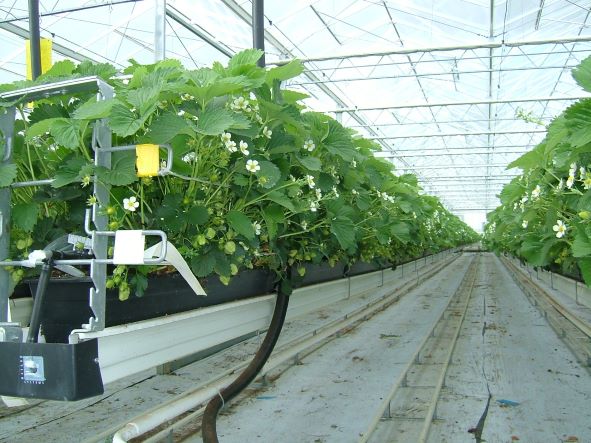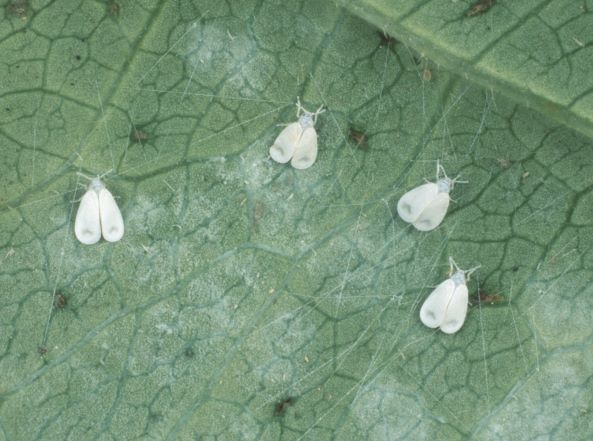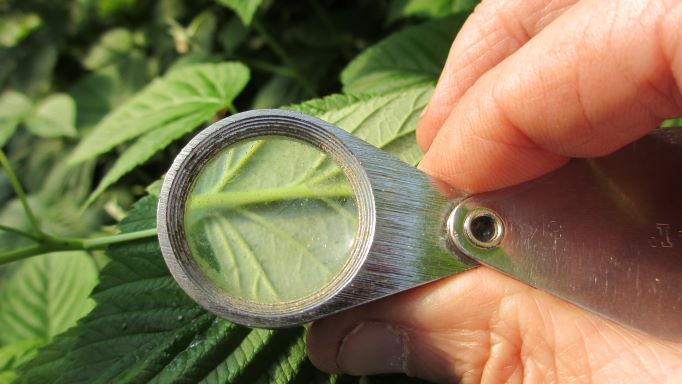Please click here to access the main AHDB website and other sectors.
- Home
- Knowledge library
- Tarsonemid mite on strawberry: Identification, spread and monitoring
Tarsonemid mite on strawberry: Identification, spread and monitoring
Read this page to understand the biology of tarsonemid mites, how to identify them, and find out how they spread through a strawberry crop.
This information was last updated in 2018.
Identification
Regular inspections of the crop should take place to identify pests before plant damage begins to occur. Crop Walker Guides can help in the identification of pests and diseases.
However, tarsonemid mites are only 0.2-0.25 mm in length, making them difficult to detect - especially early in the season or if populations in the plants are small. With practice, it is possible to see tarsonemid mites using a x10 or x20 hand lens.
The adult mites are pale brown and oval in shape and move slowly between the leaf hairs.
Immature mites (larvae) are smaller and whitish.
The eggs are oval and whitish and can be distinguished from other particles on the leaves by their shiny appearance. Eggs are approximately half the length of the adult females (see Figure 1).
, larvae and female adult (pale brown), NIAB.jpg) NIAB
NIAB
Figure 1. Top left: Tarsonemid mite adult female (pale brown, elliptical shaped). Main image: Tarsonemid mite eggs (oval whitish structures) and larvae (similar to adults but white).
Life cycle
- Female adult tarsonemid mites overwinter deep in the crowns of plants, although the survival rates are thought to be low (<10%).
- Males are not known to overwinter in outdoor crops.
- Eggs are laid mostly along the main vein of leaves (up to 50 per female) but can be found between the folded leaflets. Egg laying begins when temperatures rise in the spring and individual females can lay 1-3 eggs per day.
- Eggs hatch into 6-legged opaque white larvae which develop and then pupate before becoming adults.
- Mating is not required for females to produce offspring. However small numbers of males (5% or less) are produced later in the season, when populations are high in the plant, and at this stage sexual reproduction occurs.
- The size of the pest population is influenced by temperature. In heated glass and polythene tunnel grown crops, the higher temperatures allow for more rapid rates of reproduction, so the pest, if present in such crops, is more likely to cause damage.
 AHDB
AHDB
Figure 2. The pest reproduces more rapidly under higher temperatures afforded by glass and polythene structures.
Crucially, the higher the temperature, the more rapid the rate of development.
At 25°C, typical in protected crops, the mite can develop from egg to adult in only 9 days. See Table 1 for more detail on how temperature effects development rate.
|
Temperature oC |
Egg stage |
Nymph + Pupa |
Total days |
|
10.0 |
17.3 |
- |
|
|
12.5 |
11.9 |
16.5 |
28.4 |
|
15.0 |
10.0 |
14.0 |
24.0 |
|
17.5 |
7.3 |
8.0 |
15.3 |
|
20.0 |
4.7 |
7.6 |
12.3 |
|
25.0 |
4.0 |
4.8 |
8.8 |
Table 1. Effect of temperature on the development time (days) of strawberry tarsonemid mite life stages (from Easterbrook et al 2003).
Spread
Tarsonemid mite can be introduced to the crop on new planting material.
Once the crop is growing, spread can also occur through husbandry practices such as crown thinning, runner removal and harvesting, with the pest being transported on the hands or clothing of workers or on packaging material.
Little data is available to quantify this or how much the mite can move on air currents.
Overseas research has also shown tarsonemid mites to exhibit phoresy, an association which allows them to cling to other insects to allow movement from place to place.
They have been shown to move on whitefly, but it is likely that they move on other pests too (see Figure 3).
The mite can also crawl, allowing rapid spread to occur once the plant canopy develops and enabling the mites to move from infested to neighbouring uninfested plants along leaves and runners in search of new leaf material to feed on.
 RSK ADAS
RSK ADAS
Figure 3. Tarsonemid mite can be carried by whitefly and possibly some other pests of strawberry
Monitoring
Severe crop damage will be obvious to those monitoring a crop by the appearance of areas of stunted plants with rough, twisted leaves and leaf-edge curl.
However, if crop monitoring is carried out correctly, the pest should be identified before severe symptoms develop.
To monitor for tarsonemid mite, remove and inspect unfolded young leaves in the crown of the plant.
Open the folded leaves and inspect them using a hand lens (see Figure 4).
If present, mites can be seen at the petiole end of the leaf along the main vein.
Tarsonemid mite can also be found in runner tips as the tips grow away from the plant, so this is another good place to inspect for presence of mites.
 RSK ADAS
RSK ADAS
Figure 4. Tarsonemid mites can be seen with a hand lens.
Action plan for monitoring
- Crops should be monitored systematically and regularly to avoid plant damage and yield loss.
- Start monitoring in spring shortly after new growth has begun.
- It is recommended that each strawberry field is examined at least fortnightly, and preferably weekly, for pests and diseases during the growing season.
- A sample of at least 50 young folded leaves from the plant crowns should be inspected following a zigzag transect across the crop, sampling one leaf per plant.
- An attempt should be made to focus on sampling from plants that look, potentially, damaged by tarsonemid mite to increase the likelihood of identifying the problem.
- With experience, mites can be seen with a x10 or x20 hand lens although x20 is often more reliable. For those with less experience, it is wise to examine leaves under a microscope until confidence in detection and identification is acquired.
Author/s
The content for these web pages was authored for AHDB by Michelle Fountain and Jerry Cross (NIAB).
Topics:
Sectors:
Tags:

